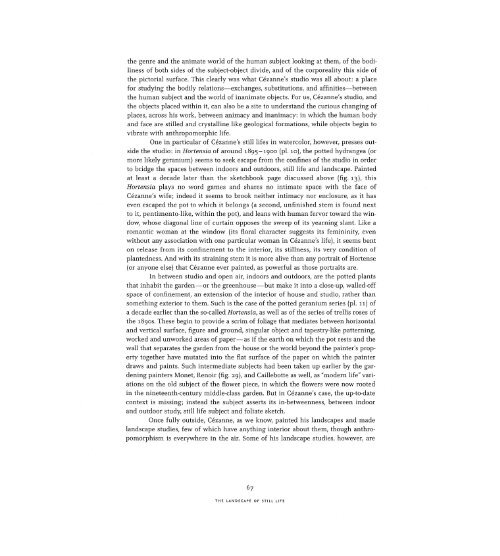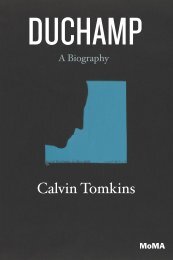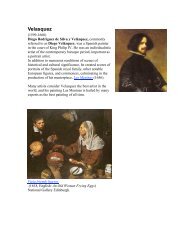Still Life in Watercolors
qbj8dgc
qbj8dgc
- No tags were found...
You also want an ePaper? Increase the reach of your titles
YUMPU automatically turns print PDFs into web optimized ePapers that Google loves.
the genre and the animate world of the human subject look<strong>in</strong>g at them ; of the bodil<strong>in</strong>ess<br />
of both sides of the subject-object divide, and of the corporeality this side of<br />
the pictorial surface. This clearly was what Cezanne's studio was all about: a place<br />
for study<strong>in</strong>g the bodily relations—exchanges, substitutions, and aff<strong>in</strong>ities—between<br />
the human subject and the world of <strong>in</strong>animate objects. For us, Cezanne's studio, and<br />
the objects placed with<strong>in</strong> it, can also be a site to understand the curious chang<strong>in</strong>g of<br />
places, across his work, between animacy and <strong>in</strong>animacy: <strong>in</strong> which the human body<br />
and face are stilled and crystall<strong>in</strong>e like geological formations, while objects beg<strong>in</strong> to<br />
vibrate with anthropomorphic life.<br />
One <strong>in</strong> particular of Cezanne's still lifes <strong>in</strong> watercolor, however, presses outside<br />
the studio: <strong>in</strong> Hortensia of around 1895-1900 (pi. 10), the potted hydrangea (or<br />
more likely geranium) seems to seek escape from the conf<strong>in</strong>es of the studio <strong>in</strong> order<br />
to bridge the spaces between <strong>in</strong>doors and outdoors, still life and landscape. Pa<strong>in</strong>ted<br />
at least a decade later than the sketchbook page discussed above (fig. 13), this<br />
Hortensia plays no word games and shares no <strong>in</strong>timate space with the face of<br />
Cezanne's wife; <strong>in</strong>deed it seems to brook neither <strong>in</strong>timacy nor enclosure, as it has<br />
even escaped the pot to which it belongs (a second, unf<strong>in</strong>ished stem is found next<br />
to it, pentimento-like, with<strong>in</strong> the pot), and leans with human fervor toward the w<strong>in</strong>dow,<br />
whose diagonal l<strong>in</strong>e of curta<strong>in</strong> opposes the sweep of its yearn<strong>in</strong>g slant. Like a<br />
romantic woman at the w<strong>in</strong>dow (its floral character suggests its fem<strong>in</strong><strong>in</strong>ity, even<br />
without any association with one particular woman <strong>in</strong> Cezanne's life), it seems bent<br />
on release from its conf<strong>in</strong>ement to the <strong>in</strong>terior, its stillness, its very condition of<br />
plantedness. And with its stra<strong>in</strong><strong>in</strong>g stem it is more alive than any portrait of Hortense<br />
(or anyone else) that Cézanne ever pa<strong>in</strong>ted, as powerful as those portraits are.<br />
In between studio and open air, <strong>in</strong>doors and outdoors, are the potted plants<br />
that <strong>in</strong>habit the garden—or the greenhouse—but make it <strong>in</strong>to a close-up, walled-off<br />
space of conf<strong>in</strong>ement, an extension of the <strong>in</strong>terior of house and studio, rather than<br />
someth<strong>in</strong>g exterior to them. Such is the case of the potted geranium series (pi. 11) of<br />
a decade earlier than the so-called Hortensia, as well as of the series of trellis roses of<br />
the 18905. These beg<strong>in</strong> to provide a scrim of foliage that mediates between horizontal<br />
and vertical surface, figure and ground, s<strong>in</strong>gular object and tapestry-like pattern<strong>in</strong>g,<br />
worked and unworked areas of paper—as if the earth on which the pot rests and the<br />
wall that separates the garden from the house or the world beyond the pa<strong>in</strong>ter's property<br />
together have mutated <strong>in</strong>to the flat surface of the paper on which the pa<strong>in</strong>ter<br />
draws and pa<strong>in</strong>ts. Such <strong>in</strong>termediate subjects had been taken up earlier by the garden<strong>in</strong>g<br />
pa<strong>in</strong>ters Monet, Renoir (fig. 29), and Caillebotte as well, as "modern life" variations<br />
on the old subject of the flower piece, <strong>in</strong> which the flowers were now rooted<br />
<strong>in</strong> the n<strong>in</strong>eteenth-century middle-class garden. But <strong>in</strong> Cezanne's case, the up-to-date<br />
context is miss<strong>in</strong>g; <strong>in</strong>stead the subject asserts its <strong>in</strong>-betweenness, between <strong>in</strong>door<br />
and outdoor study, still life subject and foliate sketch.<br />
Once fully outside, Cézanne, as we know, pa<strong>in</strong>ted his landscapes and made<br />
landscape studies, few of which have anyth<strong>in</strong>g <strong>in</strong>terior about them, though anthropomorphism<br />
is everywhere <strong>in</strong> the air. Some of his landscape studies, however, are<br />
67<br />
THE LANDSCAPE OF STILL LIFE




